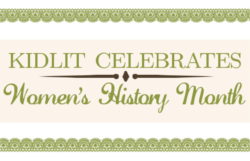Do-It-Yourself
Programming with Children’s Books on Women in Science
March 13 - Today's post provided by Penny Peck
Hands-on crafts are a great way to celebrate women scientists and
inventors. This post is a little
different than the others contributed so far, which focus on reviewing great
children’s books on the topic of women in history. Today, I am going to outline some simple
do-it-yourself programming ideas tied to children’s books on these women and
their accomplishments.
Hands-on do-it-yourself programming can be relatively easy and much more
affordable than other programming for many libraries, since the costs are just
some simple arts and craft supplies. You
can do a program offering all these activities at separate stations, as part of
a Women’s History program or festival.
Have two high school volunteers at each station, to help younger
children, to monitor the craft supplies, and to keep things moving. Having a refreshment table and a display of
these books and others on the topic will make for a great program!
You can also offer just one or a few of these activities as a “passive
program.” Just set up the supplies for
one activity, along with a poster outlining the instructions, for parent and
child to do together at a library table.
These activities can also be adapted to the classroom, bookstore, or
museum, since they fall into the type of “living history” activities that are
so popular.
Here are ten books and a hands-on activity relating to each, which would
be a great focus for a Women’s History and Science program:
Pluto’s Secret: An
Icy World’s Tale of Discovery by Margaret Weitekamp and David DeVorkin,
Abrams, 2013: Celebrate Venetia Burney,
the 11-year-old girl who named planet Pluto in 1930, who is profiled in this
new book on the “former” planet. Make a
model of Pluto and its moon, as seen here: http://www.ehow.com/how_4841372_styrofoam-replica-pluto.html.
Look Up! Henrietta
Leavitt, Pioneering Woman Astronomer by Robert Burleigh, Simon & Schuster,
2013: Leavitt was only 25 years old when she discovered the scientific
importance of a star’s brightness. This picture book biography introduces her
to children, who can make paper tube telescopes in her honor: http://easypreschoolcraft.blogspot.com/2011/11/paper-towel-roll-telescope-craft.html.
Life in the Ocean:
The Story of Oceanographer Sylvia Earle by Claire A. Nivola, Farrar, Straus and
Giroux, 2012: Oceanographer Sylvia Earle is the subject of this biography, that
also stresses the importance of preserving the ocean for the well-being of our
planet. Make these Japanese Carp Kites: http://www.freekidscrafts.com/japanese_carp_kite-e336.html.
Rachel Carson and
Her Book That Changed the World by Laurie Lawlor, Holiday House, 2012: The
pioneering environmentalist is profiled in this picture book biography. To help children remember the importance of
protecting the environment, make one of these recycling garden crafts: http://www.planetpals.com/recycle_crafts_gardening.html.
Me…Jane by Patrick
McDonnell, Little Brown, 2011: This 2012 Caldecott Honor book depicts the life
of Jane Goodall, noted scientist on chimpanzee behavior. Make one of these
paper puppet monkeys: http://www.dltk-teach.com/rhymes/monkeys/puppet.htm.
In the Bag!
Margaret Knight Wraps It Up by Monica Kulling, Tundra Books, 2011: Mattie Knight
was a factory worker who loved to tinker and make things. She is best-known for inventing a machine to
make paper grocery bags we still use today.
Make paper bag vests, and decorate them with markers: http://craftclub.com/craft/brown-bag-vest.
The Elephant
Scientist by Caitlin O’Connell, Houghton Mifflin, 2011: Part of the “Scientists
in the Field” series, O’Connell describes her career studying elephants in the
African scrub desert. Make these
elephant pencil holders: http://crafts.kaboose.com/elephant.html.
Summer Birds: the
Butterflies of Maria Merian by Margarita Engle, Henry Holt, 2010: In the 1600’s,
Maria Merian studied butterflies at a time when very few knew about the life
cycle of most insects. Make a beautiful
caterpillar craft, which changes into a butterfly: http://www.daniellesplace.com/html/caterpillarcrafts.html.
Girls Think of
Everything: Stories of Ingenious Inventions by Women by Catherine Thimmesh,
Houghton Mifflin, 2000: Several women inventors are profiled in this clever
collective biography, with witty illustrations by Melissa Sweet. Let these
stories inspire kids to make their own inventions, using a variety of
materials. See some ideas here: http://kids.lovetoknow.com/wiki/Invention_Ideas_for_Kids.
The Wright Sister:
Katharine Wright and Her Famous Brothers by Richard Maurer, Roaring Brook Press,
2003: The Wright Brothers would have had a tough time inventing the airplane
without the support of their sister Katharine, who managed their appointments
and help them make money from their invention. For a related activity, make
paper airplanes using instructions from books at the library or here: http://www.paperairplaneshq.com/easy-paper-airplane-designs.html.
Stone Girl, Bone
Girl: the Story of Mary Anning by Laurence Anholt, Orchard Books, 1999:
Anning was only 12 years old when she discovered a giant ichthyosaur skeleton
near her home in England. Make an Ichthyosaurus out of clay or Playdoh,
resembling the one seen here: http://www.kidsdigdinos.com/Dinosaurs/ichthyosaurus.htm.
Penny Peck is a
part-time faculty member of San Jose State University’s School of Library and
Information Science, and author of three books on library service to youth,
including Readers’ Advisory for Children
and Tweens (Libraries Unlimited, 2010).
Penny is also the editor and contributor to the Bayviews and More Blog, http://bayviewsandmore.wordpress.com/ which is the blog for the Association of
Children’s Librarians of Northern California.
























Terrific ideas! I just tweeted about your creative projects and programs -- not only will librarians and teachers love them, but parents too! I'm off to check out Bayviews and More Blog -- excited to find out about it.
ReplyDeleteLove this pairing of books with activities! Pinned and tweeted.
ReplyDeleteGreat ideas, Penny. Kids might also like to try methods for sending hidden messages that women spies used. My coauthor and my book, "In Disguise! Undercover with Real Women Spies," has instructions for making an ancient Greek Skytale, a 16th-century Cardano Grille, a recipe for invisible ink, and more hands-on activities.
ReplyDeleteGreat ideas! I had no idea the Wright Brothers had a sister, a few years back my husband and I visited the Dayton Aviation Heritage NHS and there was no mention of her at all.
ReplyDeleteHi
ReplyDelete